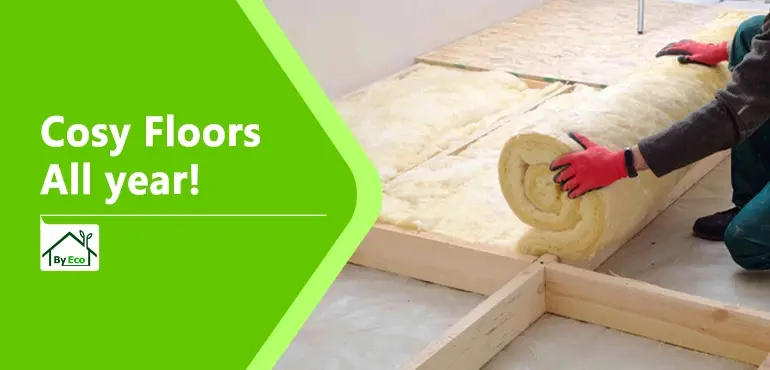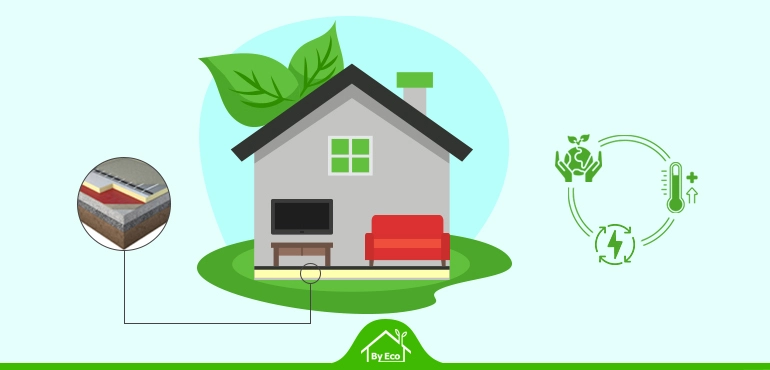What Is Underfloor Insulation?

Underfloor insulation is increasingly recognized as a critical component in enhancing the energy efficiency of homes in the UK. Suspended Floor Insulation is common in older homes with timber floors that are raised above the ground, creating a gap or void. This type of floors, unlike concrete or screed floors, allow more heat to escape. This makes insulation crucial for improving the comfort and energy efficiency of homes with such flooring. Insulating suspended floors typically involves placing insulating materials between the joists, which helps to reduce heat loss.
Underfloor insulation is one of the energy efficiency measures available under the ECO4 scheme (Energy Company Obligation 4). This scheme is designed to help low-income, vulnerable, and fuel-poor households in the UK reduce their energy bills and improve the energy efficiency of their homes. Underfloor insulation can significantly reduce heat loss through floors, leading to lower heating costs and a more comfortable living environment.
What is Underfloor Insulation?
Underfloor insulation involves installing insulating material beneath the floorboards of a property, particularly in homes with suspended timber floors. This helps to prevent heat from escaping through the floor, which can be a significant source of energy loss, especially in older properties.
Key Details About Underfloor Insulation Under the ECO4 Scheme:
- Eligibility Criteria:
- Income-Related Benefits: Households where someone receives certain income-related benefits, such as Universal Credit, Pension Credit, or Income Support, are typically eligible for underfloor insulation under the ECO4 scheme.
- Vulnerable and Fuel-Poor Households: Even if you do not receive benefits, you might still qualify if your household is considered vulnerable or fuel-poor. This can include homes with low energy efficiency ratings or residents with health conditions that are exacerbated by the cold.
- Property Suitability: The property must have a suitable floor type for underfloor insulation. This measure is most commonly applied to homes with suspended timber floors, where there is a crawl space or void underneath the floorboards.
- Types of Underfloor Insulation:
- Suspended Timber Floors: For homes with suspended timber floors, insulation is typically installed between the floor joists. This can be done from below (if there is access via a crawl space) or from above, by lifting the floorboards.
- Solid Floors: While less common, solid floors can also be insulated. This usually involves adding a layer of insulation on top of the existing floor, followed by a new layer of flooring. However, this can be more disruptive and might involve raising the floor level slightly.
- Funding:
- Fully Funded: For eligible households, the ECO4 scheme may cover the full cost of installing underfloor insulation, including materials and labor.
- Partially Funded: In some cases, you may need to contribute to the cost of the insulation, depending on the level of funding available and the specifics of your situation.
- Benefits of Underfloor Insulation:
- Energy Savings: Insulating the floor can reduce heat loss by up to 15%, leading to significant savings on your energy bills.
- Improved Comfort: Underfloor insulation helps to maintain a more consistent indoor temperature, making your home warmer in the winter and cooler in the summer.
- Reduced Draughts: Proper insulation can help to eliminate draughts coming up through the floorboards, further improving comfort.
- Lower Carbon Footprint: By reducing the amount of energy needed to heat your home, underfloor insulation helps lower your carbon emissions, contributing to environmental sustainability.
Unlock Free Underfloor Insulation: Are You Eligible?
Discover if you qualify for our free underfloor insulation, for eligible homes, thanks to our partnership with the government through schemes like the ECO4 Scheme. This initiative is designed to help UK homeowners and tenants enhance their home's energy efficiency at no charge. Do you want to know if you are eligible? Simply fill out our form to find out.
Which Underfloor Insulation is Best?
Selecting the right underfloor insulation depends on several factors, including the type of flooring and the specific requirements of your property. Our professional team conducts a comprehensive assessment of your home to recommend the most effective insulation solution.

Steps After Eligibility
- If you're a tenant: we coordinate with your landlord to ensure all contributions and permissions are in place.
- Home Assessment: Our assessors will visit to pinpoint the ideal energy solution for you.
- Scheduling Your Installation: We arrange installation at your convenience, using verified installers to do the job right.
Enhancing Your Home's Energy Efficiency Further
Beyond underfloor insulation, consider solid wall insulation to reduce your carbon footprint and energy bills. Installed correctly, they make your home warmer in winter and cooler in summer. Explore more energy-saving solutions that we offer.
Why Choose ByEco?
ByEco, your ally in renewable energy, offers the Free Underfloor Insulation Grant, fully supported by the UK government and provided at no installation cost for eligible homes. We make sustainable living accessible, ensuring financial barriers don't stop you from improving your home's energy efficiency. With ByEco, every project contributes to a greener planet. Start your eco-friendly journey with us, free of charge.

Get Started with ByEco
Begin your journey to a more sustainable and energy-efficient home today with our free consultation. Let us assist you in applying for the UK government-backed Free Underfloor Insulation Grant, specifically available to eligible homes. Enhancing your home’s energy efficiency benefits not just the planet, but your personal comfort as well. Fill out our form or contact us directly to upgrade your property with our eco-friendly solutions, all at absolutely no cost for qualifying households.
